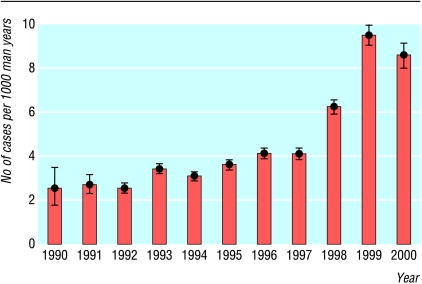Erectile dysfunction, the consistent inability to achieve or maintain an erection sufficient for satisfactory sexual performance, is reported to occur in association with cardiovascular disease, diabetes, hypertension, hypercholesterolaemia, smoking, spinal cord injury, prostate cancer, genitourinary surgery, psychiatric disorders, and the use of many drugs, including alcohol.1 Sildenafil (Viagra), an oral treatment for erectile dysfunction that was licensed in the United Kingdom in September 1998, selectively inhibits cyclic guanosine monophosphate specific phosphodiesterase type 5, thereby enhancing the vasodilating effect of endogenous nitric oxide. Sildenafil is contraindicated in men being treated with organic nitrates and should be used with caution in men with cardiovascular disease.2 Because sildenafil has been promoted extensively, and because no large, population based studies on the incidence of erectile dysfunction had been reported from the United Kingdom, we were interested in the incidence of the disorder and the characteristics of men with a diagnosis and whether these changed after the introduction of sildenafil.
Subjects, methods, and results
We used data up to April 2001 from 272 practices contributing to the UK general practice research database.3,4 Cases were men aged 40-79 years with at least two years of recorded medical history who had a first time diagnosis of erectile dysfunction that was recorded between January 1990 and December 2000. We compared cases before (January 1990 to August 1998) and after (September 1998 to December 2000) the introduction of sildenafil. We matched cases with comparison patients who had no recorded diagnosis of erectile dysfunction. Comparison patients were matched to the cases in a ratio of 5:1 by sex, year of birth, general practice, and date of diagnosis. We calculated a prevalence ratio for various conditions by dividing the prevalence of the condition at the time of first diagnosis of erectile dysfunction by the prevalence among the comparison patients.
We identified 10 371 first time recorded cases of erectile dysfunction for an estimated 2.3 million man years of observation. The annual incidence of erectile dysfunction increased gradually during the mid-1990s then rose twofold to threefold during the years 1998 to 2000 (figure). The increase occurred in all age groups (40-49, 50-59, 60-69, and 70-79 years).
The prevalence of ischaemic heart disease among men with erectile dysfunction decreased from 15.7% to 11.3% after sildenafil was introduced, and the prevalence ratio decreased from 1.51 (95% confidence interval 1.42 to 1.61) to 0.89 (0.81 to 0.99) (see table A on bmj.com). Current nitrate use also decreased. Prevalence ratios were even lower for men who were prescribed sildenafil (table B on bmj.com). The prevalence ratios for diabetes, hypertension, hyperlipidaemia, and smoking changed less or did not change significantly.
Comment
Recorded diagnoses of erectile dysfunction more than doubled after sildenafil was introduced in the United Kingdom. This does not necessarily mean that the number of men with erectile dysfunction increased. The prevalence of ischaemic heart disease among men with erectile dysfunction decreased after the introduction of sildenafil. However, doctors should not be any less concerned about the possibility of undiagnosed ischaemic heart disease in men presenting with erectile dysfunction. The clinical characteristics of men with a diagnosis of erectile dysfunction evidently changed at least in part because of a contraindication or precaution in the use of the new drug.
Studies into the causes of erectile dysfuntion should consider the period in which the study population was identified. Moreover, the inverse association we observed between ischaemic heart disease and erectile dysfunction calls into question the value of observational studies that compare the risk of adverse cardiovascular events among sildenafil users with the risk among the general population.5
Supplementary Material
Figure.
Annual incidence (95% confidence intervals) of erectile dysfunction among men aged 40-79, before and after introduction of sildenafil in 1998 in the United Kingdom
Acknowledgments
We thank Susan Jick and Brian Bradbury for their helpful comments on an earlier version of the manuscript and the general practitioners who contribute information to the general practice research database.
Footnotes
Funding: The Boston Collaborative Drug Surveillance Program is supported by grants from Abbott Laboratories, Berlex Laboratories, GlaxoSmithKline, Hoffmann-La Roche, Ingenix Pharmaceutical Services, Johnson & Johnson Pharmaceutical Research and Development, Pharmacia Corporation, and Novartis Farmacéutica.
Competing interests: None declared.
Two tables comparing prevalences of medical conditions appear on bmj.com
References
- 1.Lue TF. Erectile dysfunction. N Engl J Med. 2000;342:1802–1813. doi: 10.1056/NEJM200006153422407. [DOI] [PubMed] [Google Scholar]
- 2.Ralph D, McNicholas T. UK management guidelines for erectile dysfunction. BMJ. 2000;321:499–503. doi: 10.1136/bmj.321.7259.499. [DOI] [PMC free article] [PubMed] [Google Scholar]
- 3.Jick H, Jick SS, Derby LE. Validation of information recorded on general practitioner based computerised data resource in the United Kingdom. BMJ. 1991;302:766–768. doi: 10.1136/bmj.302.6779.766. [DOI] [PMC free article] [PubMed] [Google Scholar]
- 4.Jick H, Terris BZ, Derby LE, Jick SS. Further validation of information recorded on a general practitioner based computerized data resource in the United Kingdom. Pharmacoepidemiol Drug Saf. 1992;1:347–349. [Google Scholar]
- 5.Shakir SAW, Wilton LV, Boshier A, Layton D, Heeley E. Cardiovascular events in users of sildenafil: results from first phase of prescription event monitoring in England. BMJ. 2001;322:651–652. doi: 10.1136/bmj.322.7287.651. [DOI] [PMC free article] [PubMed] [Google Scholar]
Associated Data
This section collects any data citations, data availability statements, or supplementary materials included in this article.



